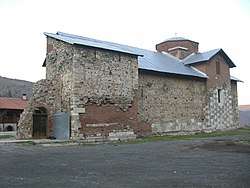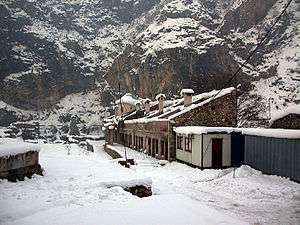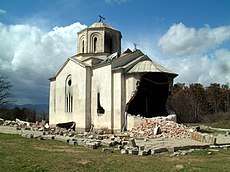Destruction of Serbian heritage in Kosovo
Serbian cultural sites in Kosovo were systematically vandalized and destroyed over several historical periods, during the Ottoman rule, World War I, World War II, Yugoslav communist rule, Kosovo War and 2004 unrest.
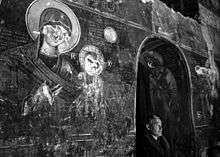
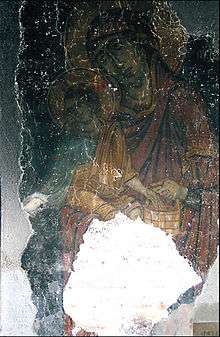
Right: 14th-century icon from UNESCO World Heritage Site Our Lady of Ljeviš in Prizren damaged during 2004 unrest in Kosovo.
Because of Serbian medieval history and monuments, Kosovo has been called by Serbs as the "Serbian Jerusalem".[1][2] Patriarchate of Peć was built in the 13th century and became the residence of the Serbian Archbishops. The region of Kosovo was an important part of the 14th-century Serbian Empire, with Prizren serving as capital, until the Ottoman invasion and conquest following the Battle of Kosovo (1389), considered one of the most notable events of Serbian history.[3] During the Ottoman reign, the constant persecutions of Serbs caused migrations to regions under the rule of Habsburg Monarchy.[4]
According to the International Center for Transitional Justice, 155 Serbian Orthodox churches and monasteries were destroyed by Kosovo Albanians between June 1999 and March 2004.[5] The Medieval Monuments in Kosovo, founded by the Nemanjić dynasty, is a combined World Heritage Site consisting of four Serbian Orthodox Christian churches and monasteries. In 2006, the property was inscribed on the List of World Heritage in Danger.[6][7]
Ottoman Empire
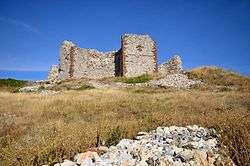
The Banjska Monastery founded by Serbian King Stefan Milutin was burnt down following the Ottoman invasion and the monastery was looted during the Ottoman occupation of Medieval Serbia.[8] It was damaged again during the 16th century, after which it was abandoned until a mosque was built on the ruins in the 17th century.[8] The entire complex suffered the greatest destruction after the withdrawal of the Ottoman army from the Great Turkish War.[8]
After the capture of Prizren and its surroundings in 1455 by the Ottoman Empire, the Monastery of the Holy Archangels founded by Serbian Emperor Stefan Dušan was looted and destroyed.[9] At the beginning of the 17th century, a systematic demolition was conducted on the monastery churches and it is widely considered that construction material was used to build the Sinan Pasha Mosque in the same city, but such claims have not been proven.[9][10]
At the close of the 17th century, the Ottoman Turks plundered the Visoki Dečani monastery, but made no serious damage.[11] In the first half of the 18th century the Our Lady of Ljeviš in Prizren had been converted into a mosque and adjusted to the needs of services characteristic of Islam.[11]
The 16th century Church of St. Nicholas in the municipality of Lipljan was pulled down in 19th century and construction material was sold to built Kosovo railway.[12][13][14] The medieval Novo Brdo Fortress and the town were heavily damaged by disintegration in 1892 when the cornerstone referred to the construction of barracks in Pristina.[15]
World War I
During World War I, the Visoki Dečani monastery's treasures were plundered by the Austro-Hungarian Army, which occupied Serbia between 1915 and 1918.[16]
World War II
Following the invasion of Yugoslavia (6–18 April 1941), the Axis powers divided the country among themselves with parts of Kosovo assigned to German, Bulgarian and Italian occupational zones. The Italian zone was the largest and attached to Axis occupied Albania in an enlarged "Greater Albania", while the German zone was included in German-occupied Serbia, and southeastern parts into the Bulgarian occupational zone.[17]
During the occupation, part of the Serb population was subject to expulsion, internment, forced labour, torture, destruction of private property, confiscation of land and livestock, destruction and damaging of monasteries, churches, cultural-historical monuments and graveyards.[17] There were waves of violence against Serbs in some periods, such as April 1941, June 1942, September 1943, and continuous pressure in various ways. Civilians were sent to camps and prisons established by the Italian, German and Bulgarian occupation, and the Albanian community.[17] Medieval monasteries St. Mark of Koriša and Devič were looted, vandalized and desecrated by Albanian Nazis.[12] The Visoki Dečani was targeted for destruction by the Albanian nationalist Balli Kombëtar and Italian fascist blackshirts in mid-1941. The Royal Italian Army responded by sending a group of soldiers to help protect the monastery from attack.[18]
SFR Yugoslavia
The Orthodox Cathedral of the Holy Trinity in Gjakova was destroyed by the communists in 1949.[19][20] Prior to 1968, the Yugoslav state carried out the desctruction of churches, the listing of church properties as state cultural heritage, the seizure of church and monastery artifacts to be displayed in state museums, as well as, the appropriation of property for state functions.[21] During 1968 and 1981 protests, Serbian Orthodox religious sites were the target of vandalism, while vandalism continued during the 1980s.[22] On March 1981, the Patriarchal Monastery of Peć was set in fire, which destroyed a 2,000-square meter residential section along with valuable furniture, rare liturgical books and some monastery's treasury.[23]
Kosovo War and aftermath
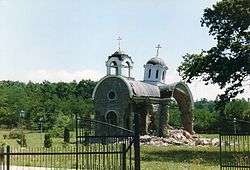
NATO bombing in March–June 1999 resulted in the damaging of Gračanica, the Patriarchal Monastery of Peć complex of four churches, as well as the Visoki Dečani, among the more notable churches.[24] Cultural historian András Riedlmayer stated that no Serbian Orthodox churches or monasteries were damaged or destroyed by the KLA during the war.[25] However, in the aftermath of war, KLA fighters were accused of vandalizing Devič monastery and terrorizing the staff. KFOR troops said KLA rebels vandalized centuries-old murals and paintings in the chapel and stole two cars and all the monastery's food.[26][27] Karima Bennoune, United Nations special rapporteur in the field of cultural rights, referred to the many reports of widespread attacks against churches committed by the Kosovo Liberation Army.[28] In 2014, John Clint Williamson announced EU Special Investigative Task Force's investigative findings and he indicated that a certain element of the KLA following the conclusion of the war (June 1999) intentionally targeted minority populations with acts of persecution that also included desecration and destruction of churches and other religious sites.[29] Fabio Maniscalco, an Italian archaeologist, specialist about the protection of cultural property, described that KLA members seized icons and liturgical ornaments as they ransacked and that they proceeded to destroy Christian Orthodox churches and monasteries with mortar bombs after the arrival of KFOR.[30]
Within post-conflict Kosovo Albanian society, calls for retaliation for previous violence done done by forces of the Slobodan Milošević regime during the war circulated through public culture.[25]The destruction of Serbian architectural heritage was interpreted by Albanians within that postconflict context as architecture becoming a surrogate for forces held responsible committing violence during the war needing to be avenged, in particular the Milošević government and its army.[25] Such fabrication of interpreting architecture as unavenged violence resulted in the mediation of an idea present at the time that destruction of churches and monasteries entailed not only revenge for violence during the 1998—99 war; but also for a chain of real or imagined violent actions going far back as the medieval building of churches upon "crypto-Albanian" religious sites.[25]
Widespread attacks against Serbian religious sites commenced following the conflict and the return of hundreds of thousands of Kosovo Albanian refugees to their homes.[31] Between the arrival of the Kosovo Force (KFOR) in June 1999 and the 2004 unrest in Kosovo, more than 140 holy sites were destroyed.[32] Destruction was carried out in a systematic manner.[33][34] András Riedlmayer, Andrew Herscher and Tonka Kostadinova described the destruction of Serbian architectural heritage as revenge attacks.[31][33] These discourses of viewing Serbian historical architecture as a surrogates of violence within Kosovo Albanian society had the effect of justifying destruction as an endless process, instead of working toward a politics of justice.[25] "Part III examines the destruction of architectural surrogates of unavenged violence in postwar Kosovo. After the 1998—99 war, calls for retribution for prior violence inflicted by Serb forces against Kosovar Albanians circulated through Kosovar Albanian public culture. The postconflict destruction of Serbian Orthodox churches and monasteries was narrated as a form of this retribution, with architecture becoming a surrogate for the agencies deemed responsible for the violence to be avenged—initially the Milošević regime and its military forces. The fabrication of architecture as a surrogate for unavenged violence, however, not only mediated an already constituted concept of violence but also ramified on that concept; the destruction of churches and monasteries represented not only revenge for the violence of the 1998—99 war but also a continuous sequence of actual or imagined violent acts stretching back to the medieval construction of churches on crypto-Albanian religious sites. The destruction of architectural surrogates of violence thereby elicited a potentially endless justification for destruction rather than a politics of justice."[25] Due to vandalisation, the need arose for the armed force of the UN to protect locations containing Serbian religious heritage in Kosovo.[35] On the other hand, foreign correspondent Robert Fisk criticized describing the destruction as revenge attacks.[36] He explained that the destruction actions were planned and described them as “vandalism with the mission”.[36]
List of religious buildings demaged or destroyed in 1999
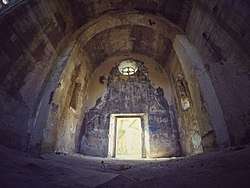
- Holy Trinity Monastery "Rusinica" in Mušutište (14th century), dynamited and burned down in July 1999, only the bell tower remains[37][38]
- Church of the Virgin Hodegetria, Mušutište (14th century), burned down and dynamited in July 1999[39][38]
- Monastery of St. Mark of Koriša in Koriša (15th century), burned down and razed to ground in July 1999[40][38]
- Church of the Holy Archangels in Gornje Nerodimlje (14th century, renewed in 1700), set on fire and looted, and seriously damaged by explosive, the old cemetery desecrated[38]
- Church of the Holy Apostles Peter and Paul, Suva Reka (built in 1938), demolished by explosive in July 1999[38]
- Holy Trinity Cathedral in Gjakova (originally built in 1940, renovated in 1998/99), completely destroyed by explosive on 24 July 1999[38]
- Church of Holy Trinity, Petrič (built in 1993), completely destroyed in 1999[41][38]
- Church of St. Nicholas, Slovinje (16th century), completely demolished by explosive in July 1999[38]
- Presentation of the Virgin church in Dolac (built in 1620), completely demolished in August 1999[38]
- Devič Monastery in Srbica (15th century), pillaged and torched, the tomb of St. Joanikije of Devič was desecrated in June 1999.[42][43] The KFOR troops said KLA rebels vandalized centuries-old murals and paintings in the chapel.[44][45]
- Church of St. Nicholas, Prizren (14th century, reconstructed in 1857), mined on 3 September and severely damaged[38], later renovated
- St. Archangel Gabriel's Monastery in Binač (14th century), completely destroyed by explosive on 13 December[38]
- St. Uroš Monastery in Gornje Nerodimlje (14th century), completely destroyed in summer 1999[38]
- Church of the Holy Virgin in Koriša (16th -17th century), church and the cemetery were destroyed in summer 1999[38]
- Holy Trinity Church in Ratiš (built in 1922, destroyed in 1941 and reconstructed in 1992). In summer 1997 the church was set on fire and was reconstructed again. In June 1999 the church was finally mined and completely destroyed.[38]
- Church of St Mark in Klina , heavily damaged in summer 1999[38]
- Church of St. Nicholas, Donje Nerodimlje (built in 1983), vandalized and set on fire in July 1999 [38]
- Church of the Presentation of the Blessed Virgin Mary in Belo Polje (16th century), looted and set on fire in June 1999[38]
- Church of St. John the Baptist, Samodreža (14th century, reconstructed in 1932), vandalized and burnt in June 1999[46]
- Church of Saint Elijah, Vučitrn (built in 1834), vandalized and looted in June 1999[38]
- St. Eliah's Church in Bistražin (reconstructed in 1994), vandalized and damaged by an explosion in June 1999[38]
- Church of Holy Trinity, Velika Reka (built in 1998), vandalized and set on fire in June 1999[38]
- Church of the Holy Emperor Uroš in Uroševac (built in 1933), burnt in June 1999[47]
- Parish church St. Eliah in Žegra (built in 1931), vandalized and set on fire, local graveyard is also desecrated[38]
- St. Elias Church in Smać (built in 1996), damaged by explosive and vandalized in July 1999[38]
- Church of St. Paraskeva, Drsnik (built 1560/1570), interior torched in June 1999, later renovated[48],
- Parish church in Grmovo, near Vitina, first it was set on fire and then completely destroyed by explosive.[38]
- Church of St Nicholas in Gatnje near Uroševac (built in 1985), looted, vandalized and seriously damaged by explosive[38]
- Church of St. Nicolas in Kijevo, near Klina (14th century), completely destroyed by explosive[38]
- Church of St. Elijah, Podujevo (built in 1929), vandalized in July 1999[38]
- The parish church in Novake near Prizren, vandalized and damaged[38]
- Church of the Holy Prophet Elijah in Pomazatin (erected in 1937), roof and the interiors were burnt. Parts of it destroyed by mines.[38]
- Church of St George, in Rudnik near Srbica (14th century), seriously damaged by explosive[38]
- Church of St Archangel in Mušutište, set on fire and partially destroyed in summer 1999[38]
- The Church of St Parasceva, in the village of Zaskok near Urosevac, mined and completely destroyed in summer 1999[38]
- Church of St. Jeremiah in Grebnik (built in 1920), razed to ground and terrain leveled with bulldozers
- Church of St. George, Rečanе (14th century), destroyed by explosive in June 1999[49]
- Monastery of the Holy Archangels in Prizren (14th century), looted and devastated in June-July 1999[50], the 14th century Pine of Tsar Dušan was cut down and burned[51]
- Church of the Virgin, Naklo (built in 1985), burnt and destroyed in June 1999[52]
- Church of St. John the Baptist, Pećka Banja (built in 1998), demolished and the interiors burnt in June 1999
- Church of St. Nicholas, Đurakovac (built in 14th century, renovated in 1592), dynamited in July 1999, large centuries old oak tree was cut into peaces and burned[49]
- Church of the Holy Mother of God, Podgorce (consecrated in 1996), vandalized and burnt
- Church of the Holy Trinity in Babljak near Uroševac (re-built in 1966), demolished and interior burned in 1999[40]
2004 unrest
Postwar, Albanian Kosovan media, supportive of and controlled by Albanian resistance groups, induced a climate of fear among local journalists toward preventing balanced coverage of violence perpetrated by both sides.[53] It generated a nationalist media campaign that drove and coordinated successive attacks against locations that contained Serbian heritage.[53]
In an urgent appeal,[54] issued on 18 March by the extraordinary session of the Expanded Convocation of the Holy Synod of Serbian Orthodox Church (SPC), it was reported that a number of Serbian churches and shrines in Kosovo had been damaged or destroyed by rioters. At least 30 sites were completely destroyed, more or less destroyed, or further destroyed (sites that had been previously destroyed).[32] Apart from the churches and monasteries, tens of support buildings (such as parish buildings, economical buildings and residences), bringing the number close to 100 buildings of the SPC destroyed.[32] All churches and objects of the SPC in Prizren were destroyed.[32] The list includes several UNESCO World Heritage Sites.
The violence quickly spread to other parts of Kosovo, with Kosovo Serb communities and religious and cultural symbols attacked by crowds of Albanians. Some of these locations were ostensibly under the protection of KFOR at the time. During the riots and violence, eight Kosovo Serbians were killed. Among damaged property was the targeted cultural and architectural heritage of the Serb people, and as a result 35 churches, including 18 monuments of culture, were demolished, burnt or severely damaged.[55]
List of religious buildings demaged or destroyed in 2004
| Site(s) | Location | History | Damage |
|---|---|---|---|
| Our Lady of Ljeviš (Bogorodica Ljeviška) | Prizren | 14th c. World Heritage Site | Set on fire from the inside, 12th–14th c. frescos seriously damaged, altar area desecrated, holy table broken[32] |
| Church of the Holy Saviour | Prizren | 14th c. | Set on fire[32] |
| Cathedral of Saint George | Prizren | Built in 1856 | Set on fire and mined[32] |
| Church of St. Nicholas (Tutić's Church) | Prizren | 14th c. | Set on fire from the inside[32] |
| Church of St. George (Runović's Church) | Prizren | 16th c. | Set on fire from the inside[32] |
| Church of St. Kyriaki (Crkva sv. Nedelje) | Potkaljaja neighbourhood, Prizren | 14th c. | Burnt[32] |
| Church of St. Panteleimon | Potkaljaja | 14th c. | Burnt[32] |
| Church of Sts. Cosmas and Damian | Potkaljaja | 14th c. | Burnt[32] |
| Church of St. Kyriaki (Crkva sv. Nedelje) | Živinjane near Prizren | - | Mined, completely destroyed by explosion[32] |
| Monastery of the Holy Archangels | Prizren | 14th c. founded by Stefan Dušan | Robbed and burnt, in the presence of German soldiers who failed to protect it[32] |
| Serbian Orthodox Seminary of Prizren and the Bishop's Court | Prizren | Established in 1872 | Set on fire[32] and people attacked on 17 March.[56] |
| Church of St. Elijah | Podujevo | destroyed and desecrated, coffins from the nearby Serbian cemetery were dug up, and bones of the dead were scattered away.[57] |
Reconstruction
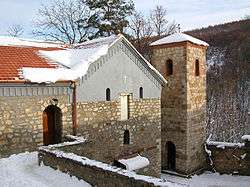
The Reconstruction Implementation Commission (RIC) for Serbian Orthodox religious sites in Kosovo is an EU-funded project to promote the reconstruction of cultural heritage.[58] It has 35 sites under its responsibility.[59]
See also
- List of destroyed heritage
- Anti-Serbian sentiment
- Destruction of Albanian heritage in Kosovo
References
- Bataković 2007.
- "The Medieval Monasteries of Kosovo". The New York Times. 13 September 2016., "Kosovo: The Jerusalem of Serbia". The Washington Post. July 1999.
- Cox, John K. (2002). The History of Serbia. Westport, Connecticut: Greenwood Press. ISBN 9780313312908.CS1 maint: ref=harv (link)
- Casiday, Augustine (2012), The Orthodox Christian World (PDF), Routledge
- Edward Tawil (February 2009). "Property Rights in Kosovo: A Haunting Legacy of a Society in Transition" (PDF). New York: International Center for Transitional Justice. p. 14.
- "Kosovo: Protection and Conservation of a Multi-Ethnic Heritage in Danger" (PDF). UNESCO. April 2004.
- Ferrari, Professor Silvio; Benzo, Dr Andrea (2014). Between Cultural Diversity and Common Heritage: Legal and Religious Perspectives on the Sacred Places of the Mediterranean. ISBN 9781472426017.
- Israeli, Raphael (2018). Kosovo: The Loss by Complacency: The Relic and Reminder of Ottomanism in the Balkans. Strategic Book Publishing & Rights Agency. pp. 5–6. ISBN 9781948858793.CS1 maint: ref=harv (link)
- Milinković, Mihailo (1996). НОВА АРХЕОЛОШКА ИСТРАЖИВАЊА КОМПЛЕКСА СВ. АРХАНЂЕЛА КОД ПРИЗРЕНА [New archeological excavation of St. Archangel complex near Prizren]. Гласник Српског Археолошког друштва 11 (in Serbian). Belgrade: 208–224. Archived from the original on 2011-10-07.CS1 maint: ref=harv (link)
- Kaleshi, Hasan (1972). Najstariji vakufski dokumenti u Jugoslaviji na arapskom jeziku (in Serbo-Croatian and Albanian). Prishtine: Rilindja. pp. 257–264. Retrieved 2010-08-14.
- "World Heritage Scanned Nomination: Dečani monastery" (PDF). UNESCO. 2002.
- United States Congress; Commission on Security and Cooperation in Europe (2001). Kosovo's Displaced and Imprisoned: Hearing Before the Commission on Security and Cooperation in Europe, One Hundred Sixth Congress, Second Session, February 28, 2000. pp. 113–118.
- Subotić, Gojko (1998). Art of Kosovo: the sacred land. The Monacelli Press. p. 249.
- Lidov, Aleksey (1998). Косово: Ортходокс херитаже анд контемпорары катастрофе. Индрик. p. 325.
- "Revitalization of Novo Brdo Fortress - Preliminary Management Plan". UNESCO Office in Venice. 9 October 2006. p. 73.
- Mitrović, Andrej (2007). Serbia's Great War, 1914–1918. West Lafayette, Indiana: Purdue University Press. p. 230. ISBN 978-1-55753-477-4.CS1 maint: ref=harv (link)
- Nenad, Antonijević (2009). Albanski zločini nad Srbima na Kosovu i Metohiji: Dokumenta (PDF) (2nd ed.). Kragujevac, Belgrade: Muzej žrtava genocida.CS1 maint: ref=harv (link)
- Judah, Tim (2002). Kosovo: War and Revenge. New Haven, Connecticut: Yale University Press. p. 287. ISBN 978-0-300-09725-2.CS1 maint: ref=harv (link)
- "Fury as Park Built on Kosovo Church Remains". Balkan Insight. Retrieved 12 June 2020.
- "Preliminary technical assessment report on the religious buildings/ ensembles and cultural sites damaged in march 2004 in Kosovo". Council of Europe. Retrieved 12 June 2020.
- Herschert 2010, p. 54.
- Di Lellio, Anna (2006). The Case for Kosova: Passage to Independence. Anthem Press. p. 39-40. ISBN 9780857287120.
- Perica, Vjekoslav (2002). Balkan Idols: Religion and Nationalism in Yugoslav States. Oxford University Press. p. 123. ISBN 9780195174298.CS1 maint: ref=harv (link)
- Ćurčić 2000, pp. 126–128.
- Herschert 2010, p. 14.
- "KLA rebels accused of vandalizing Serb monastery". New York: CNN. 17 June 1999.
- "Žak Ogar: Hoću da svedočim o zločinima OVK, ali me ne zovu". Belgrade: Večernje Novosti. 3 February 2019.
- ""Stop denying the cultural heritage of others," UN expert says after first fact-finding visit to Serbia and Kosovo*". Geneva: United Nations High Commissioner for Human Rights. 14 October 2016.
- "Statement of Chief Prosecutor" (PDF). Center for Euro-Atlantic Studies. 29 July 2014.
- Fabio Maniscalco. "The Loss of the Kosovo Cultural Heritage" (PDF).
- András Riedlmayer. "Introduction in Destruction of Islamic Heritage in the Kosovo War, 1998-1999" (PDF). p. 11.
Remarkably, not a single Serb Orthodox church or monastery in Kosovo was damaged or destroyed by Albanians during the 1998-1999 conflict. Unfortunately that changed after the end of the war, as thousands of Albanian refugees who had been forced out of Kosovo during the war returned to their burned-out home towns and villages. Following the end of hostilities in June 1999, dozens of Serb Orthodox churches and monasteries were damaged in revenge attacks.
- ERP KiM Info 2004.
- Kostadinova, Tonka (2011). "Cultural Diplomacy in War-Affected Societies: International and Local Policies in the Post-conflict (Re)construction of Religious Heritage in Former Yugoslavia" (PDF). Institute for Cultural Diplomacy, Berlin: 11. Cite journal requires
|journal=(help)CS1 maint: ref=harv (link) - Ćurčić 2000, p. 129.
- Brosché et al. 2017, p. 250.
- Robert Fisk. "Nato turns a blind eye as scores of ancient Christian churches are reduced to rubble". The Independent.
- Popović, Danica (2000). "Манастир Св. Тројице Русинице - Успони и разарања". Историјски часопис. XLV-XLVI: 31–48 – via academia.
- "DESTRUCTION OF THE SERBIAN ORTHODOX CHURCHES AND MONASTERIES IN KOSOVO AND METOHIJA". Archived from the original on 2000-03-04.
- "Mušutište: Suze Bogorodice Odigitrije teku našom Belom rekom". www.novosti.rs (in Serbian). Retrieved 2020-05-18.
- Folić, Ljubiša. (1999). Crucified Kosovo--destroyed and desecrated Serbian Orthodox churches in Kosovo and Metohia, June-October, 1999 = b Raspeto Kosovo--uništene i oskrnavljene srpske pravoslavne crkve na Kosovu i Metohiji, jun-oktobar, 1999. "Glas Kosova i Metohije" medijsko-izdavački centar Eparhije Rasko-prizrenske Srpske Pravoslavne crkve. LCCN 2001364933. OCLC 47099371.
- Beta. "Raseljeni Srbi proslavili seosku slavu u razrušenom selu na Kosovu". Blic.rs (in Serbian). Retrieved 2020-05-19.
- "CNN - KLA rebels accused of vandalizing Serb monastery - June 17, 1999". edition.cnn.com. Retrieved 2014-03-03.
- http://www.sv-luka.org/Kosovo2000Part1.pdf
- "KLA rebels accused of vandalizing Serb monastery". New York: CNN. 17 June 1999.
- "Žak Ogar: Hoću da svedočim o zločinima OVK, ali me ne zovu". Belgrade: Večernje Novosti. 3 February 2019.
- Танјуг. "Црква у Самодрежи поново претворена у јавни тоалет". Politika Online. Retrieved 2020-05-19.
- "ISPOVEST MLADOG SVEŠTENIKA IZ UROŠEVCA: Živimo kao da smo u zatvoru". www.novosti.rs (in Serbian). Retrieved 2020-05-18.
- KoSSev (2015-07-04). "Osrkrnavljena crkva Svete Petke u Drsniku". KoSSev (in Serbian). Retrieved 2020-05-18.
- "Kosovo". www.kosovo.net. Retrieved 2020-05-18.
- "Monastery of the Holy Archangels – FEASIBILITY STUDY" (PDF). web.archive.org. Ministry of Culture of the Republic of Serbia. 2009-02-15. Archived (PDF) from the original on 2009-02-15. Retrieved 2020-05-18.
- Gaber, Rita. "After the War: The Destruction and Preservation of Sacred Sites in Kosovo". Sacred Sites International Foundation. Archived from the original on 2013-04-07. Retrieved 2020-05-19.
- "Nakon dvadeset godina očišćeno pravoslavno groblje i crkva u selu Naklo". www.radiokontaktplus.org (in Serbian). Retrieved 2020-05-19.
- Brosché, Johan; Legnér, Mattias; Kreutz, Joakim; Ijla, Akram (2017). "Heritage under attack: motives for targeting cultural property during armed conflict". International Journal of Heritage Studies. 23 (3): 254. doi:10.1080/13527258.2016.1261918.CS1 maint: ref=harv (link)
- Appeal from the extraordinary session of the Expanded Convocation of the Holy Synod of Serbian Orthodox Church
- B92.net, FM talks Kosovo at U.S. college Archived 2011-03-20 at the Wayback Machine, 18 March 2011
- Bouckaert 2004, pp. 54–55.
- Munk, Eva (25 March 2004). "Czechs hold line in Kosovo". The Prague Post. Archived from the original on 1 February 2013.
- Reconstruction Implementation Commission (13 May 2009). "Home". Council of Europe. Retrieved 9 December 2010.
- Reconstruction Implementation Commission (13 May 2009). "Sites". Council of Europe. Retrieved 9 December 2010.
Sources
- Books
- Bouckaert, Peter (2004). Failure to Protect: Anti-minority Violence in Kosovo, March 2004. Human Rights Watch. GGKEY:XX8XTDK4E19.CS1 maint: ref=harv (link)
- Duijzings, Ger (2000). Religion and the Politics of Identity in Kosovo. C. Hurst & Co. Publishers. ISBN 978-1-85065-431-5.CS1 maint: ref=harv (link)
- Ferrari, Silvio; Benzo, Andrea (2014). Between Cultural Diversity and Common Heritage: Legal and Religious Perspectives on the Sacred Places of the Mediterranean. London & New York: Routledge. ISBN 9781317175032.CS1 maint: ref=harv (link)
- Herscher, Andrew (2010). Violence taking place: The architecture of the Kosovo conflict. Stanford: Stanford University Press. ISBN 9780804769358.CS1 maint: ref=harv (link)
- Government
- Влада Републике Србије за Косово и Метохију. "Светиње и културна добра уништени у мартовском погрому" (PDF). Cite journal requires
|journal=(help) - Влада Републике Србије за Косово и Метохију. "Судбина културне баштине на Косову и Метохији" (PDF). Cite journal requires
|journal=(help) - Влада Републике Србије за Косово и Метохију. "Уништена и оштећена културна добра на Косову и Метохији у периоду од 1999. до 2004. године" (PDF). Cite journal requires
|journal=(help) - Влада Републике Србије за Косово и Метохију. "Угрожена културна добра на Косову и Метохији" (PDF). Cite journal requires
|journal=(help)
- Journals
- Slobodan Mileusnić (27–29 May 2005). "ДУХОВНИ ГЕНОЦИД - КУЛТУРНА КАТАСТРОФА (КОНТИНУИТЕТ ЦРКВЕНОРУШИТЕЉСТВА НА КОСОВУ И У МЕТОХИЈИ)" (PDF). СРБИ НА КОСОВУ И У МЕТОХИЈИ. SANU. Archived from the original (PDF) on 4 March 2016. Retrieved 24 November 2015.
- Ćurčić, Slobodan (2000). "Destruction of Serbian Cultural Patrimony in Kosovo: A World-Wide Precedent?". JNASSS. 14 (2): 125–31.
- Other
- Avramović, S., Rakitić, D., Menković, M., Vasić, V., Fulgosi, A. and Jokić, B. (2010). "The Predicament of Serbian Orthodox Holy Places in Kosovo and Metohia: Elements for a Historical, legal and Conservational Understanding" (PDF). Monographs 41. Belgrade: University of Belgrade Law Faculty.CS1 maint: multiple names: authors list (link)
- ERP KiM Info (26 April 2004). "Dopunjeni i ispravljeni spisak uništenih i oštećenih pravoslavnih crkava i manastira na Kosovu u toku martovskog nasilja". B92 Specijal. B92.CS1 maint: ref=harv (link)
External links
- „Porušeni manastiri na Kosovu i Metohiji“ on YouTube, Office for Kosovo and Metohija (in English and Serbian)
